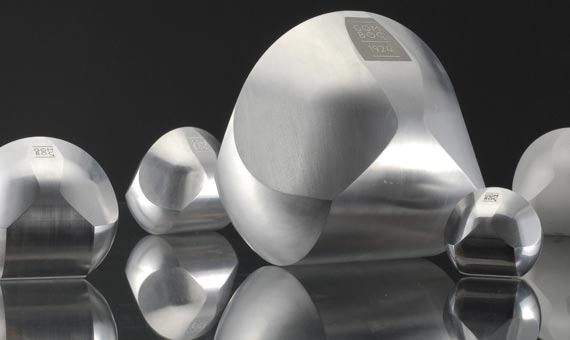The world’s first homogenous self-righting object, invented by two Hungarian scientists is the highlight and central theme of the Hungarian Pavilion at the World Expo 2010 in Shanghai.
For the first time after the success of the Rubik’s Cube in 1979, the world’s mathematicians talk about a Hungarian invention again. The subject is an object that looks just like a rock paperweight, but is, in fact, a new geometric shape. “The question of whether it is possible to construct a three-dimensional body which is mono-monostatic but also homogeneous and convex was raised by Russian mathematician Vladimir Arnold in 1995,” says Gábor Domokos, one of the inventors. “We were the first ones who managed to prove this kind of object’s existence by presenting Gömböc Nr.1., after ten years of work, detailed design programs, and hundreds of tests with rocks of different types. “In one experiment, we have tried 2,000 pebbles collected at the beaches of Rhodes Island and found no single mono-monostatic body among them,” Domokos illustrates the difficulty to find or construct such a body. The prototype was finally produced in the summer of 2006, made of brown plexi glass and personally delivered on August 20, 2007 by the inventors to Professor Arnold for his 70th birthday. In 2007, Gömböc was featured among the seventy most interesting inventions of the year in the New York Times Magazine.
Ups and Downs
The Gömböc is a convex object having just one stable and one unstable point of equilibrium. Like a tumbler, it can return to its originally upright state no matter how you fiddle with it. However, unlike the tumbler, which concentrates its weight at the bottom and is not homogeneous, Gömböc is homogeneous. “The shape is not unique, it has countless varieties, most of which are very close to a sphere and all have very strict shape tolerance,” the scientist tells Diplomacy and Trade. Its shape resembles a little the body structure of the shell of the Indian Star Tortoise. “Its manufacturing process is unusual and unique, because the smallest mistake can destroy the functionality,” Domokos says. “A variance of 0.01 mms could stop working a Gömböc with a diameter of 10 cm. This performance can only be reached by milling machines, which are digitally automated via computer numerical control (CNC). The balancing properties of a Gömböc are affected by mechanical defects and dust both on its body and on the surface on which it rests. If damaged, the process of restoring the original shape is more complex than producing a new one. “The current materials a Gömböc can be made of include alloy, brass, copper, stainless steel, plexi glass and marble, and even with the current up-to-date technology, it takes several hours to produce one,” Domokos says. Gömböcs made for special orders get a serial number and an information card.
Shanghai
“Gömböc will be a center element of the Hungarian Pavilion at the World Expo 2010 in Shanghai, China,” says a proud Domokos. A 2.5-meter tall steel form of Gömböc will represent Hungary. Acting upon the slogan of „Better City, Better Life”, the Hungarian Pavilion, with its 1,000 square meters, will be constructed along the architectural principles of innovation, creativity and environment consciousness. “The characteristics of the Gömböc, that it is so complex, rare, easy to destroy, but always stands upright, reflect Hungary and the Hungarian nation,” Domokos reveals. The Gömböc will be placed at the middle of the pavilion,” he adds. “In addition, there will be more than 10 small Gömböcs made of various materials on display, letting visitors experience the feature of it turning back to its original state after being shaken. The inventors are interested to find a polyhedral solution with the surface consisting of a minimal number of flat plaines. Therefore, they offer a prize to anyone who finds such solution, which amounts to USD 10,000 divided by the number of plans in the solution. “By offering this prize, we wish to stimulate the finding a radically different solution from our own,” Domokos states.
Design
By now, Gömböc is protected by design, trademark and copyright world-wide, and is manufactured for sale by Gömböc Ltd. “Our brainchild has been named one of the greatest Hungarian inventions in the 21st century,” Domokos adds. “Our website www.gomboc.eu has received over ten million hits from 202 countries, with visitors from over 1, 000 universities including the world's top research facilities.” Copies of Gömböc have been donated to institutions and museums: Gömböc Nr. 1896 went to the Hungarian Patent Office with the number representing the founding year of the Office, while Nr.1825 was donated to the Hungarian Academy of Sciences and Nr. 1924 was a gift to the Hungarian National Bank as a mere reminder of the fact, that like the Gömböc itself, the monetary system also has one stable and one unstable equilibrium only. Nr 1209 travelled to the University of Cambridge, UK while Domokos was serving as a Visiting Fellow Commoner at the institution’s Trinity College.
The inventors of the ‘Gömböc’ are often referred to as a new generation of scientists possessing legendarily ingenious Hungarian minds. Gábor Domokos got his PhD in 1989. Currently, he is a professor at the Department of Mechanics, Materials, and Structures at the Technical University of Budapest (BME). He has been a member of the Hungarian Academy of Sciences since 2004, being the youngest member of the institution. Péter Várkonyi was Silver Medalist at the Physics Student Olympics in 1997. He graduated from the Technical University of Budapest in 2003 as an architect. He got his PhD in 2006, his doctoral work was supervised by Gábor Domokos. His research fields include symmetry in engineering structures, biomechanics, and evolutionary modeling. For their discovery, Domokos and Várkonyi received the Knight's Cross of the Republic of Hungary.


Leave a Reply Cancel reply
Top 5 Articles
 Forbes Lists the Most Valuable Hungarian Companies November 2, 2023
Forbes Lists the Most Valuable Hungarian Companies November 2, 2023  MVM Buys Huge Solar Power Plant in Tázlár December 20, 2023
MVM Buys Huge Solar Power Plant in Tázlár December 20, 2023  Tensions Escalate Between U.S. and Hungary after… March 15, 2024
Tensions Escalate Between U.S. and Hungary after… March 15, 2024  Hungarian Central Bank Head Warns of Autonomy Under Threat March 1, 2024
Hungarian Central Bank Head Warns of Autonomy Under Threat March 1, 2024  Hungary Faces Economic Headwinds as Recovery Falters February 16, 2024
Hungary Faces Economic Headwinds as Recovery Falters February 16, 2024








No comment yet. Be the first!